The Lenovo ThinkPad X1 Yoga Review: OLED and LCD Tested
by Brett Howse & Brandon Chester on September 29, 2016 11:30 AM ESTGPU Performance
Once again, since this is likely the last Skylake Ultrabook to be tested here, it’s also likely our last look at Intel’s HD 520 GPU. It’s been a nice improvement over Broadwell, even though the elusive Iris version has not made it’s way here. With 24 EUs in the GT2 GPU, it ends up being reasonable for low end games, and Intel seems to be promoting integrated GPU performance with more effort recently.
The X1 Yoga was run through the standard GPU suite, with a few synthetic tests, as well as Dota 2 for a low end game that can be played on an iGPU.
3DMark

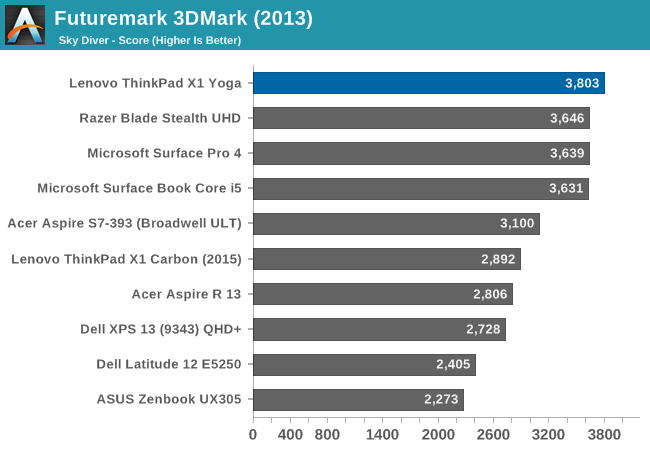
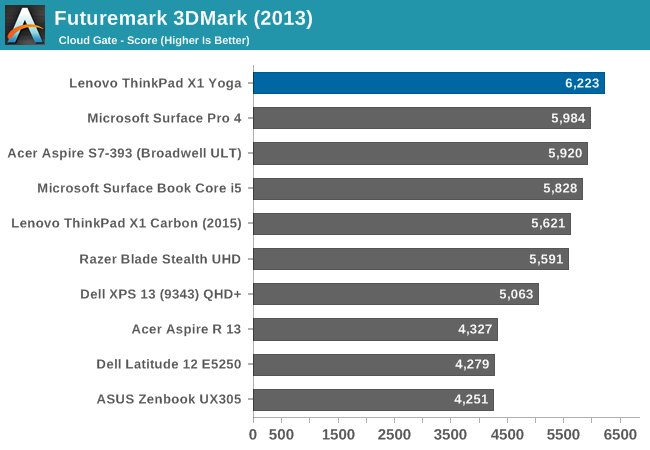
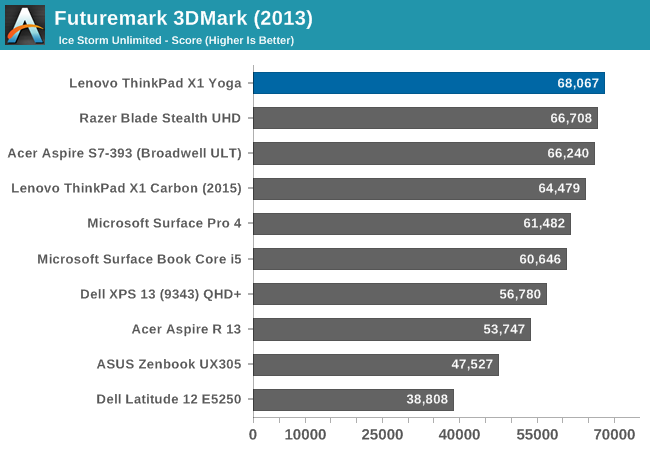
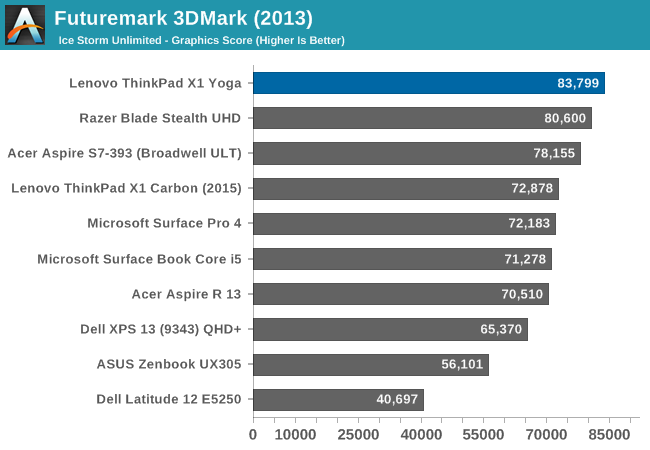
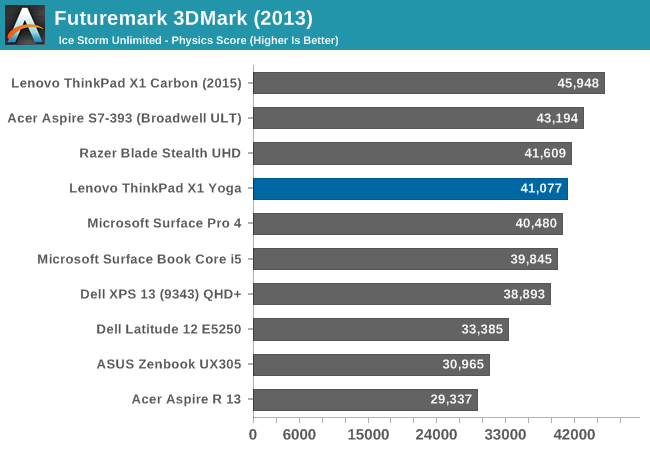
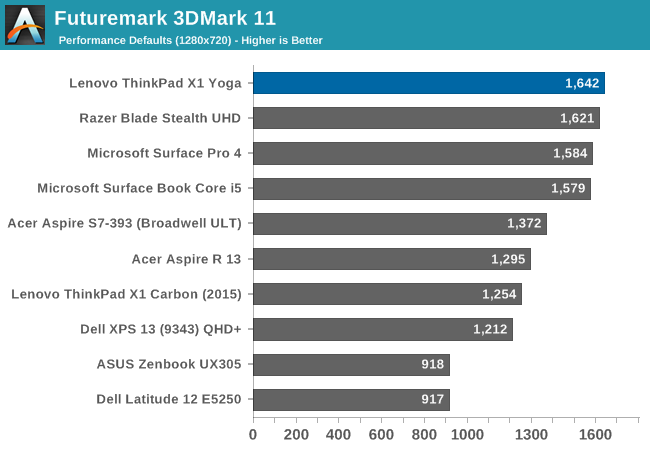
Once again, there are no surprises with the HD 520, and the X1 Yoga falls in-line with the other Skylake GT2 units.
GFXBench
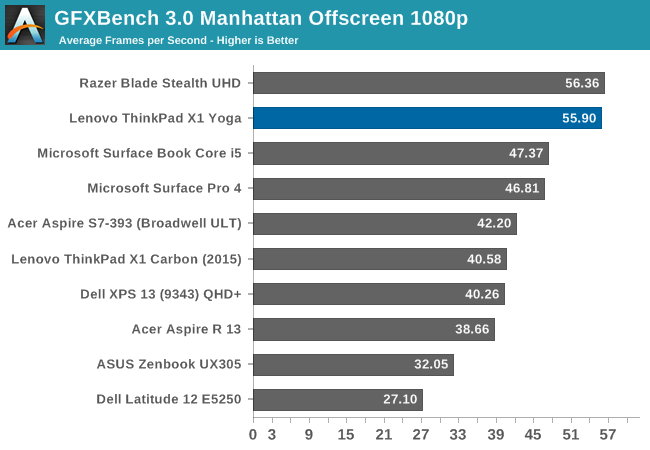
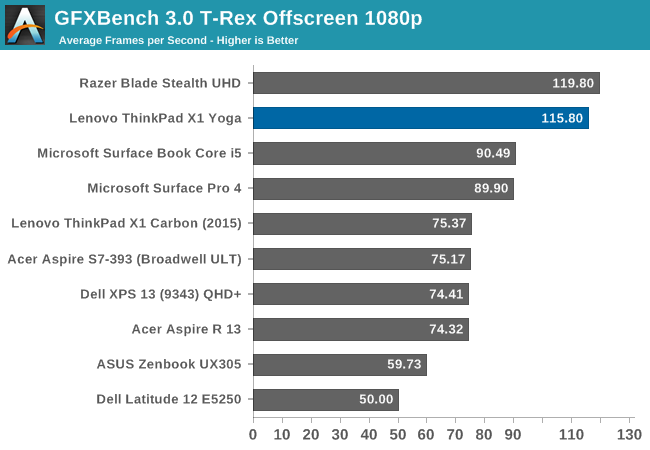
Much like 3DMark, the X1 Yoga scores similarly to the other Skylake devices tested.
Dota 2 Reborn
Valve recreated Dota 2 with a new gaming engine, which limits our selection of devices to compare against since the new Reborn version was launched. As an online game, it is also constantly updated.

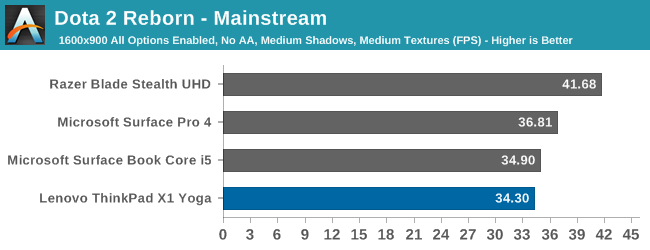
The X1 Yoga outscored the Razer Blade Stealth in the lightest test, but was unable to pass it in the higher quality tests. Due to the nature of it being an online game, with frequent updates, this could be due to game engine changes as well as driver differences between the tests (typically notebooks are only short-term review units, so it can be difficult to maintain consistency). The margins are not huge though, and although the game is somewhat playable on our medium test, it really can only be played well at the lightest settings.










84 Comments
View All Comments
overzealot - Wednesday, October 5, 2016 - link
Awesome, thanks Brett!ikjadoon - Friday, September 30, 2016 - link
I think there's a little error on battery capacity. IIRC, the OLED version actually uses a 56Wh battery, while the LCD uses 52Wh.http://www.notebookcheck.net/Lenovo-ThinkPad-X1-Yo...
So, then, the battery life for the OLED is actually even worse. :(
Lolimaster - Friday, September 30, 2016 - link
Not even my 7 years old Cowon S9 pmp shows that type of ghosting on his amoled display (pretty much zero ghosting).FXi - Saturday, October 1, 2016 - link
Interesting cross product implications from this review. Btw a very detailed review which is needed in this new type of product, kudos for not just glossing through the details but taking it head on.I note that power draw (with light screens which we knew about but good to note) being so much higher may well be a challenge to Apple going OLED. That may well cause them to implement a dark interface.
I bet Windows 10 with it's continuous approach to a dark interface may be ready for the move to OLED in more device types - though even using it you still had a severe drop in battery life.
If the gamut (which is going to be a big deal moving forward a couple years as 4k content all goes to wide gamut) had been wide on the LCD too, it would have been a fairer contrast. Wide gamut backlights on LCD's draw more power so then the comparison would have been more like to like in capability.
Often overlooked is that Nvidia (and possibly others but NV is the ones who discussed it) has for years made 10 bit wide gamut color accessible through DirectX which has supported wide gamut where the receiver (panel) could understand it. Now that would then need another culling of any actual games that have a wide gamut setting (even if invisible to the user) that activates on a wide gamut monitor, but be aware that taking advantage of wide gamut may not be restricted to just Adobe type programs. In fact the Nvidia driver has a checkbox for outputting 10 bit by force. This isn't color managed, but it begins to bridge the gap in the triple match you need of software/interface/hardware that would need to be aligned for high gamut impact.
If you'd tried a 4k HDR stream play on these devices I suspect you'd be pretty impressed at the differences.
Awesome job detecting the blur. That relates the the draw and hold driving of current panels that creates blur from the driving circuit in spite of OLED pixel draws. Yes it needs both hardware and driver level software to fix. Black frame insertion is the way to trick the brain and represents one first approach to curing this artifact. But it will come as no shock to you that the driver circuits in small devices are weak vs desktop or TV, but also that any special way of doing things now new to OLED and different from LCD is the weakest area of all. Very few houses make these kinds of chips needed for TV, fewer that can then be integrated for desktop and for mobile of laptop size, almost none. So it's going to take time and expansion of the entire market to drive new solutions as available.
Well done :)
cditty - Tuesday, October 4, 2016 - link
Easier for Apple to do OLED on the smaller screen. I'm really glad I read this article. The ghosting would have driven me crazy. I've used the FHD version of this laptop and liked it a lot (fingerprint login in particular). Makes sense to me why Apple is supposedly only using OLED on the Macbook Pro for a smaller touchpad. They won't trade off battery life. With processor and SSD technology constant now, it seems like the display (on a laptop) is the next battle point. I'm still relatively happy on a 5.5 inch phone with a 1080 screen. It's worth the extra battery life to me. A killer, accurate 1080 screen is better (to me) than a Q or UHD screen that kills the battery.I apologize for my 'all over the place' intermingling of phone and laptop discussion.
Erin Adreno - Sunday, October 2, 2016 - link
The nvme ssd speed doesn't seem right. That speed should come from a 950 pro instead of pm951.cptcolo - Saturday, November 12, 2016 - link
I am pretty sure it is a PM961 not a PM951cptcolo - Saturday, November 12, 2016 - link
I took apart mine, it indeed has a Samsung PM961 1TB SSD. I ordered mine back in June 2016.Ro_Ja - Monday, October 3, 2016 - link
It's also a good thing this laptop has the RAM in dual-channel mode. It greatly affects performance for onboard GPUs.amosbatto - Wednesday, October 5, 2016 - link
Let's talk about the longevity of this device. How hard is it to open the case and replace the parts? You didn't even bother to mention in the review that the battery is sealed in the case, which is very important when it dies after 2 years of use. Is it soldered or glued inside, or is it designed to be replaced? Is the keyboard a user replaceable part? Is the RAM soldered on the motherboard? Does the SSD use a standard connector? This is the essential information that determines whether a laptop lasts 5 years or 2 years and it is never included in any review.I just bought a Thinkpad T450s and I replaced the screen and added more RAM. The lid of the T450s is too thin to protect the screen in a fall in my opinion. The case is extremely hard to open without a plastic spudger and I marred the plastic because I only had a flat-head screw driver. Reviews used to open up laptops, but now we seem to live in a world where every device is designed for planned obsolescence.
These are important questions because the fabrication of a new laptop emits between 200 and 400 kg of CO2-equivalent. Between 60%-80% of the total energy of a laptop lies in its initial fabrication and the majority of its greenhouse gas emissions and other types of pollution are also caused by the fabrication. The best way to reduce the environmental impact is to use a device as long as possible and avoid new fabrication. I would appreciate reviews which at least give me some idea of the longevity of a device.
Another think that I would appreciate is some mention of the environmental hazards of its contents. Does it use PVC plastic and phthalates? Does it contain brominated flame retardants in the casing and motherboard? Does the screen contain arsenic? Does the manufacturer have a take-back policy, so the device can be easily recycled? For me, these are far more important questions when I buy a laptop than whether this device scores 5% better on some CPU test. I will never notice the incremental difference in the speed of the CPU, but I care whether I am being exposed to chemicals that may effect my hormones and could give my child a birth defect. Why do review sites like Anandtech never talk about whether the power cord on a laptop contains phthalates or not?